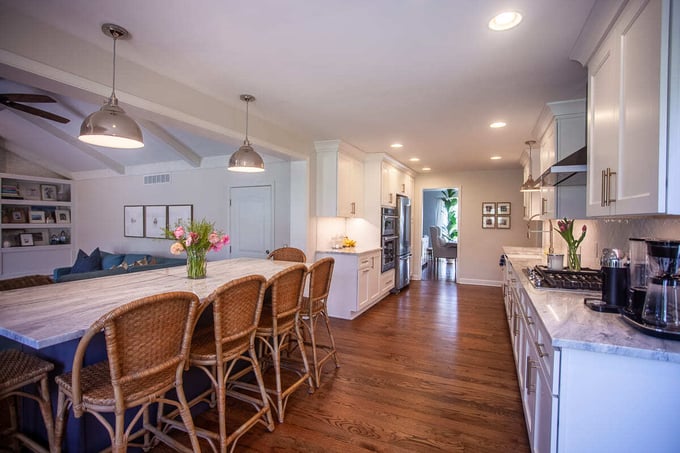What is the Best Kitchen Layout? Pros and Cons
Imagine this: it’s a Sunday morning. Sunlight pours into your kitchen through a well-placed window above the sink. Your coffee is brewing, the kids are gathered at the island, and everything you need, spices, utensils, pantry staples, is exactly where it should be. No crowding, no clutter, just a space that works with you. That’s the power of a well-designed kitchen layout.
How your kitchen is laid out will determine how it functions, how it flows, and how you feel when you're in it. At Legacy Builders Group, we believe a kitchen should also work as hard as you do. That’s why we help homeowners across Greater Cincinnati create efficient kitchen layouts that pave the way for ease and flow. In this blog, we’ll walk through the most common kitchen layouts, highlight the advantages and disadvantages of each, and offer tips to help you create a layout that elevates your everyday life.
Common Kitchen Layouts: Pros and Cons
Remodeling your kitchen is the ultimate opportunity to right the wrongs done by your current configuration. Choosing the right kitchen layout means creating an efficient, intuitive space that enhances your daily routine. Let’s explore the most popular options.

L-Shaped Kitchen
An L-shaped kitchen layout is ideal for maximizing corner space and providing generous counter surface along two connected walls. It’s a versatile option that works well in both small and medium-sized kitchens.
Advantages
-
Creates an efficient work triangle between the sink, stove, and refrigerator.
-
Opens up the space for a potential island.
-
Easy to navigate, great for households with one main cook.
Design Tip for L-Shaped Kitchens
We often use corner pull-outs and roll-out trays to make those tricky corners fully functional.
U-Shaped Kitchen
The U-shaped kitchen wraps around three walls, forming a horseshoe layout that offers abundant cabinetry and countertop space.
Advantages
-
Highly efficient for cooking with everything within reach.
-
Ideal for homes with multiple cooks.
-
Great opportunity for specialized cabinetry zones, like appliance garages or pull-out pantry systems.
Design Tips for U-Shaped Kitchens
U-shaped kitchens can feel enclosed in smaller spaces. Smart planning is key to avoiding a cramped feel. Custom cabinets help break up bulky cabinetry with glass fronts, dedicated zones, or hidden storage to make the space feel open and functional.

Galley or Two-Wall Kitchen
A two-wall kitchen layout, also known as a galley, places all appliances and storage on two parallel walls. It’s a smart choice for long, narrow spaces.
Advantages
-
Streamlined and efficient, with everything just a step away.
-
Ideal for serious cooks or compact kitchens.
Design Tips for Galley Kitchens
Because galley kitchens may feel tight, we prioritize adequate walking space and natural light. We often use lighter finishes, open shelving, and custom drawer systems like narrow-depth drawers or roll-outs to make these layouts feel more open.

One-Wall Kitchen
The one-wall kitchen layout is common in smaller homes, condos, or open loft-style spaces. All appliances and storage are positioned along a single wall.
Advantages
-
Space-saving design that opens up floor area.
-
Works beautifully under a large window to bring in natural light.
Design Tips for One-Wall Kitchens
A one-wall kitchen with an island layout creates valuable additional surface and storage, especially when outfitted with custom drawer systems.
Open Concept Kitchen
The open concept kitchen has become a favorite among homeowners who love to cook and entertain. This could be a one-wall kitchen, but it doesn't have to be. Removing walls between the kitchen and main living spaces creates a seamless connection ideal for modern lifestyles.
Advantages
-
Great for socializing and entertaining.
-
Works beautifully with a large island for seating, prep, and casual dining.
-
Creates a light-filled, expansive feel.
Design Tips for Open Concept Kitchens
This is where custom cabinetry shines, allowing us to integrate specialized storage below the counters, like pull-outs for oils and spices, utensil drawers, and hidden trash cabinets. We also pay close attention to island placement during design to ensure smooth flow and ample walking space.

Smart Design Tips for the Perfect Kitchen Layout
Whether you're an avid cook, an entertainer, or a busy parent trying to manage weeknight chaos, a smart layout makes all the difference. Here’s what our design process naturally considers when helping clients build the perfect kitchen. Especially when remodeling as part of a larger project, it helps to understand in what order to renovate a house so your kitchen plans fit into the full scope of your goals.
Start with Function First
Your layout should reflect how you use your kitchen. Do you host often? Cook daily? Need homework or laptop space for the kids? Starting with function ensures the layout supports your lifestyle, not the other way around.
Follow the “Golden Rule” of Kitchen Design
Yes, it’s real, and yes, we swear by it. The work triangle connects the sink, stove, and refrigerator to minimize steps and maximize flow. In every layout we design, L-shaped, U-shaped, or open concept, we aim to create a natural and intuitive triangle.
Think About Walking and Workflow
Especially in open concept kitchens, it’s critical to leave enough room around the island and between key stations. Too-tight aisles can turn a dream kitchen into a daily frustration. We recommend 42–48 inches between counters to allow for easy movement when multiple people are in the kitchen, and it’s smart to keep in mind the typical costs of a kitchen renovation in Cincinnati since layout adjustments can impact both budget and timeline.

Use Custom Cabinetry to Solve Problems
We design storage solutions that work with your layout and store your specific stuff.
-
Roll-out trays in deep base cabinets
-
Pull-out spice racks near the cooktop
-
Utensil drawers with built-in dividers
-
Hidden trash and recycling pullouts
-
Dedicated cabinetry for oils, baking zones, or small appliances
Prioritize Lighting and Natural Views
If you’re working with a one-wall kitchen with a window, make the most of that natural light. We love pairing those setups with an island for added function and balance. And don’t forget statement lighting over the island or sink!
Layout Strategies for Small or Challenging Kitchens
A small or oddly shaped kitchen doesn’t have to limit your vision; it just requires smarter planning. We’ve helped many Cincinnati-area homeowners rethink tight spaces, and here’s how we do it.
Maximize Corners and Vertical Space
In a limited space such as a small U-shaped kitchen design, vertical storage is key. We use tall cabinetry, slim upper cabinets, and open shelving to create the feel of more space while keeping function at the forefront. Corner cabinets with lazy Susans or roll-outs can transform dead space into smart storage.

Don’t Fight Irregular Shapes, Design Around Them
We’ve seen our fair share of irregularly shaped kitchen layouts in remodels. With custom cabinetry, we can create solutions that fit the quirks of your home—angled walls, off-center windows, or unusual nooks become opportunities for smart, one-of-a-kind design.
Choose an Island That Matches the Space
In smaller kitchens, a large island might not make sense. Instead, we might design a slimmer island or a mobile prep station with seating on one side and drawers on the other. In an open concept kitchen, we’re always thinking about how the island interacts with nearby living or dining areas.
Curious about costs? Our updated local pricing guide has the answers you need!
/Modern%20kitchen%20remodel%20with%20white%20shaker%20cabinets%20and%20window%20above%20white%20countertops%20by%20Legacy%20Builders.jpg?width=680&height=453&name=Modern%20kitchen%20remodel%20with%20white%20shaker%20cabinets%20and%20window%20above%20white%20countertops%20by%20Legacy%20Builders.jpg)
What Kitchen Layouts Do the Pros Prefer?
If you're the kind of person who likes to do extensive research to prepare for a remodel, you have likely wondered what kind of kitchen layout chefs prefer.The answer is often surprisingly simple: whatever gets the job done most efficiently. Professional kitchens prioritize workflow, and that same principle applies to residential design. The common thread? A well-planned work triangle, minimal obstruction, and intuitive access to tools and ingredients. Professional kitchen configurations often include:
-
Galley layouts for their direct, no-nonsense efficiency
-
L-shaped kitchens with islands for delineated prep
-
U-shaped kitchens when multiple people share the cooking duties
Ready to Design Your Dream Kitchen in Greater Cincinnati? Let’s Talk.
Whether you're still exploring different kitchen layouts or ready to start your remodel, the Legacy Builders Group team is here to help you get it right from the start. Schedule your design consultation today and let’s create a kitchen that truly works for you.

